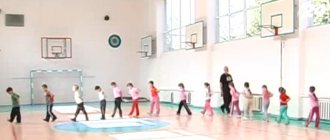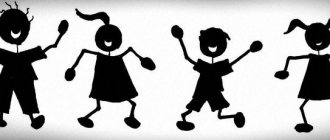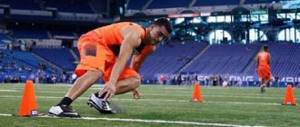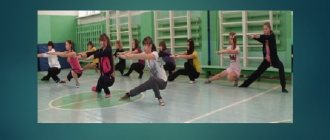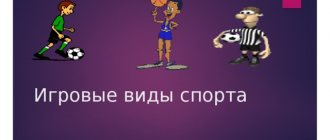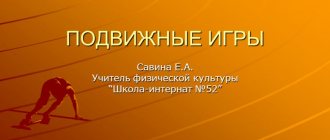Physical education standards for 2nd grade are significantly more complicated in relation to the tasks set for a first-grader. Preparation must be systematic and correct - the child gradually increases his potential and becomes able to overcome new challenges.
By the way, the physical education standards for grade 2 for boys and girls are slightly different; in this they are similar to the standards of the “Ready for Labor and Defense” program, which also has gradation by gender.
Sports disciplines: 2nd grade
Here is a list of required exercises to pass at school:
- Shuttle running 2 types (4 r.* 9 m each, 3 r.* 10 m each);
- Running: 30 m, 1000 m (time cross is not taken into account);
- Standing long jump;
- High jump using the stepping method;
- Exercises with a skipping rope;
- Pull-ups on the bar (boys only);
- Raising the body from a supine position;
- Squats;
- Multi-jumps.
According to the rules approved by the Russian educational system, in the second grade a sports lesson takes place 3 times a week for 1 academic hour.
Let's study the table of physical education standards for grade 2 for Russian schools according to the Federal State Educational Standard, and then compare them with tasks for overcoming the 1st stage of the GTO.
Safety regulations for physical education lessons
Physical education lessons involve the possibility of various types of injuries, which imposes additional responsibilities on the teacher to ensure the safety of students. Therefore, the teacher should remind every day before the start of the lesson about TB in the classroom, depending on the place where the lesson is taking place (gym, sports arena, street, etc.), as well as on the types of exercises that the children will perform.
Introductory safety regulations in physical education lessons:
- Children who have undergone full instruction on TB are allowed to attend physical education lessons.
- Only those children who have the required level of health can participate in physical education lessons.
- Children who have a partial or complete exemption from physical education must attend lessons and engage in theoretical study of the discipline.
- After an illness, in order to be admitted to a physical education lesson, the student must provide the teacher with a certificate from the medical institution where he was treated.
- For physical education, students must have special change of clothes and shoes.
- Chewing gum and eating food during classes is strictly prohibited.
Finished works on a similar topic
- Course work Safety precautions in physical education lessons and at school 440 rubles.
- Abstract Safety precautions in physical education lessons and at school 250 rub.
- Test work Safety precautions in physical education lessons and at school 210 rub.
Receive completed work or specialist advice on your educational project Find out the cost
Safety precautions in physical education lessons before the start of classes:
- Students must attend physical education classes in special sports uniforms and shoes.
- It is necessary to change clothes for class in a specially designated place (locker room; boys and girls change clothes in different locker rooms).
- The pockets of the sports uniform should not contain objects that could pose a danger during the lesson.
- Preparation of sports equipment for the lesson is carried out with the permission and under the guidance of the teacher.
- During classes, the student must accurately follow all instructions and commands of the teacher.
Safety instructions for physical education lessons during classes:
- Each student must listen to a safety briefing before the start of the lesson, only after which he can be admitted to the lesson.
- It is prohibited to leave the gym or playground without the permission of the teacher.
- It is prohibited to perform exercises independently and take sports equipment without the permission of the teacher.
- While performing the task, stay in the designated place (while running, run along your own path; while charging, stand in your place, at a safe distance from your neighbor, etc.).
- When performing tasks (running, jumping, etc.), minimize collisions and falls (keep a distance, do not stop abruptly, do not change the trajectory, etc.).
- Do not perform exercises on a wet floor or loose soil.
- Before starting a series of exercises (throwing), make sure that there are no people in the throwing sector.
- If your condition worsens or you are injured, stop completing the task and contact your teacher.
Too lazy to read?
Ask a question to the experts and get an answer within 15 minutes!
Ask a Question
Safety precautions in physical education lessons after classes:
- You cannot leave the gym or playground before the bell rings.
- Remove sports equipment only with the permission of the teacher.
- Leave the place of study at a calm pace.
- Be quiet in the locker room, do not shout, or disturb other students.
- After classes, be sure to wash your hands with soap.
Note 1
During classes on the street, it is strictly forbidden to leave the sports ground where the lesson is taking place, and especially the school grounds.
Tasks of the GTO Complex for overcoming stage 1
Physical education standards for 2nd grade schoolchildren in coinciding disciplines are very close to the objectives of the first level “Ready for Labor and Defense” program. Let us note the following points:
- The GTO table includes 9 disciplines: the student chooses 7 if he is applying for a gold badge, or 6 to receive a silver or bronze badge.
- Of the 9 tests, 4 are mandatory, 5 are optional;
| — bronze badge | - silver badge | - gold badge |
| No. | Girls | Boys | Types of tests | ||||
| Mandatory types | |||||||
| 1. | 10,6 | 10,4 | 9,5 | 10,3 | 10,0 | 9,5 | Shuttle run 3x10 m (sec.) |
| 7,1 | 6,8 | 6,2 | 6,9 | 6,7 | 6,0 | or 30m run (sec.) | |
| 2. | 7,35 | 7,05 | 6,00 | 7,10 | 6,40 | 5,20 | Mixed movement (1 km) |
| 3. | 2 | 3 | 4 | Pull-ups from hanging on a high bar (number of times) | |||
| 4 | 6 | 11 | 6 | 9 | 15 | or hanging pull-up lying on a low bar (number of times) | |
| 4 | 6 | 11 | 7 | 10 | 17 | or flexion and extension of the arms while lying on the floor (number of times) | |
| 4. | +3 | +5 | +9 | +1 | +3 | +7 | Bend forward from a standing position on a gymnastic bench (from the level of the bench - cm) |
| To choose from | |||||||
| 5. | 105 | 115 | 135 | 110 | 120 | 140 | Standing long jump with two feet push (cm) |
| 6. | 1 | 2 | 3 | 2 | 3 | 4 | Throwing a tennis ball at a target, distance 6 m (number of hits) |
| 7. | 11,00 | 9,30 | 8,30 | 10,15 | 9,00 | 8,00 | Skiing 1 km (min., sec.) |
| 9,30 | 7,30 | 6,30 | 9,00 | 7,00 | 6,00 | or mixed movement for 1 km over rough terrain* | |
| 8. | 3,00 | 2,40 | 2,30 | 3,00 | 2,40 | 2,30 | 25m swim |
| 9. | 18 | 21 | 30 | 21 | 24 | 35 | Raising the body from a supine position (number per 1 minute) |
| 9 | 9 | 9 | 9 | 9 | 9 | Number of tests per age group | |
| 6 | 6 | 7 | 6 | 6 | 7 | Number of tests that must be completed to receive the Complex insignia** | |
| * For snow-free areas of the country | |||||||
| ** When fulfilling the standards for receiving the insignia of the Complex, tests for speed, flexibility, endurance and strength are required. | |||||||
Power
This group of exercises is presented:
- throwing a medicine ball weighing 1 kg;
- throwing a small ball weighing 150 g at a distance;
- lifting the torso from a lying position (this is the same as pumping the abs);
- pulling up.
The numbers for pull-ups for boys are significantly lower than for girls. What's the matter? It should be the other way around. But the fact is that the exercises are different. The boys do pull-ups on a high bar, that is, they hang on it and puff on themselves. And the girls are on the low crossbar. They lie on their backs, grab with their hands, and do pull-ups from a lying position.
Does the school prepare for the GTO?
Few would argue that being fit, strong and fit is fashionable, so schoolchildren from a young age strive to meet the trends of today. A significant role in the sports motivation of children in Russia is played by the active functioning of the GTO Complex - a set of disciplines and standards, for the gradual completion of which a person receives a badge of distinction.
So are school sports lessons enough to prepare for the “Ready for Labor and Defense” tests or not? Let's speculate:
- If we compare school standards for physical education for 2nd grade for girls and boys with the table of GTO standards for 1st stage, it becomes clear that the parameters are almost the same, and in some places, even more difficult.
- The school program does not require swimming, bending forward from a gymnastic bench and mixed movement.
- But to pass the standards of the Complex, a child will not need to jump rope, squat, high jump and run a 1000 m cross-country race.
- If we take into account that the child has the right to exclude 2-3 disciplines, it turns out that the school perfectly develops the physical abilities of children to pass the standards of the GTO program.
A second-grader who decides to take part in the tests of the Complex must successfully pass the 1st level standards (age range 6-8 years). If these tasks still seem difficult to most first-graders, then, given the increased complexity of physical education standards according to the Federal State Educational Standard in 2nd grade, at this stage the student should quite successfully cope with these tests.
Even though not every first-grader will master stage 1, a competent and gradual increase in the load will certainly lead to a logical increase in the student’s physical potential next year. This means that the cherished badge will no longer be a transcendental dream.
Download material
so UNT / Physical education / Lesson plans for physical education 2nd grade
Lesson No. 1 (2nd grade)
21.12.2011 42645 5567
Lesson No. 1 (2nd grade)
Tasks.
Familiarize yourself with the content of classes in the new academic year. Remind safety rules during physical exercise. Talk about the importance of morning exercises.
Lesson structure.
1. Conversation in class (content of classes in the new academic year; rules of conduct and safety precautions during physical exercise; the importance of morning exercises). 2. Go to the sports ground; games. 3. Repeat the high start technique. 4. Summing up the lesson.
Class Conversation
Contents of classes in the new academic year and requirements for students.
In the second grade we will continue to learn how to run, jump, throw a ball, overcome obstacles, ski, and accurately perform gymnastic exercises; We will also learn new games. Many of the exercises are already familiar to you. But you have grown over the year, therefore, the obstacles (unlike last year) for climbing and climbing will be higher, and gymnastic exercises will be more difficult; you must throw and long jump further, and higher in height. Second grade students are required to have more strength, agility, speed, and courage. In order to develop these qualities, you need to exercise more, repeat each exercise many times, not only in physical education lessons, but also after, attending section classes or studying at home.
The lesson must begin exactly on the bell. We need to cherish every minute. Then we will have time to complete many interesting exercises, and there will be more time for games.
Safety rules during physical exercise.
General rules (see 1st grade, lesson 1).
During athletics classes. Don't push while running. During a group start for short distances, run only in your own lane. After crossing the finish line, do not stop suddenly, do not sit down, do not lie down. To avoid collisions, avoid sudden stops while running. There should be no foreign objects in the safety zone when running and jumping. Running around the stadium is carried out only in one direction by all students. You can perform jumps only after the sand in the hole has been dug up. To avoid colliding with each other during jumps, you must wait until the landing site is clear. During throwing classes, you need to make sure that there is no one in the area where the projectiles fall. You cannot throw a projectile to each other.
The importance of morning exercises.
Morning exercises (exercises) are useful and necessary for everyone. It plays an important role in the transition from sleep to wakefulness. Exercise helps quickly prepare the body for work. During its implementation, the muscles contract and relax faster, switching to active work of the cardiovascular and respiratory systems. That is why after exercise a person no longer looks sleepy, his face becomes fresh.
What else is useful for morning exercises?
When performing exercises, strength, agility, endurance, and flexibility develop. Systematic training strengthens the will - one of the most valuable qualities, without which it is difficult to count on success in any endeavor.
Go to the playground (in the school yard). ORU in service. Remind that the ability to perform this complex will be tested. Students assigned to a preparatory or special medical group are also involved in performing a set of exercises. 1) I. p. - basic stance, arms forward. 1 - arms to the sides; 2 - i. P.; 3-4 - the same. 2) I. p. - stand with legs apart, hands to shoulders. 1 - turn the body to the left, arms up; 2 - i. P.; 3-4 the same in the other direction. 3) I. p. - stand with legs apart, hands in front of the chest. 1 - tilt the body to the left, move the elbows slightly back; 2 - i. P.; 3-4 - the same in the other direction. 4) I. p. - stand, arms up. 1 - squat, arms forward; 2 - i. P.; 3-4 the same. 5) I. p. - stand, hands on the belt. 1 - bend back, arms to the sides; 2 - i. P.; 3-4 - the same. 6) I. p. - stand, arms to the sides. 1 - swing your left hand forward, arms forward, shin touching your fingers; 2 - i. P.; 3-4 - the same with the other leg. 7) I. p. - standing on the left leg, the right one is bent forward. Four jumps on the left leg, four on the right. Walking in place.
Tulking games
and
“To your flags”
(see
1st
grade, lessons 2 and 4).
Repeat the high start technique.
Remind yourself of the high start technique. Executing the commands “Start!”, “Attention!” (see 1st grade, lesson 58).
Game with performing a high start “Sparrows - Crows”
(see 1st grade, lessons 23 and 62).
Construction. Organized transition to class. Summing up the lesson.
See the downloadable file for the full text of the material.
The page contains only a fragment of the material.
physical education, lesson plans for 2nd grade
Standards for 2nd grade in physical education
Children of primary school grades are characterized by a need for increased physical activity. Moving from preschool education to systematic studies at school, a child at the age of 6-7 reduces the amount of physical activity by 50%. During study sessions, schoolchildren not only do not increase their physical activity during the transition from one class to another, but also reduce it. That is why it is extremely important to ensure that children, according to their age and health status, have a sufficient amount of daily physical activity.
Table of standards for physical education 2nd grade
| Boys | Exercise 2nd grade | Girls | ||||
| 5 | 4 | 3 | 5 | 4 | 3 | |
| 5.9 | 7.0 | 7.2 | 30 meter run (sec) | 6.6 | 7.2 | 7.4 |
| 9.1 | 10.0 | 10.4 | Shuttle run 3x10 m (sec) | 9.7 | 10.7 | 11.2 |
| 12.0 | 12.8 | 13.2 | Shuttle run 4x9 m (sec) | 12.4 | 12.8 | 13.2 |
| No time tracking | 1000 meter run | No time tracking | ||||
| 1050 | 950 | 850 | Six minute run (m) | 750 | 650 | 550 |
| 8.30 | 9.30 | 10.30 | Skiing 1 km, min, sec | 9.00 | 10.00 | 11.30 |
| 10 | 8 | 6 | Multi-jump 8 jumps (m) | 9 | 7 | 5 |
| 150 | 125 | 110 | Standing long jump (cm) | 140 | 115 | 100 |
| 60 | 50 | 40 | High jump (cm) | 50 | 40 | 35 |
| 60 | 50 | 30 | Jumping rope 60 sec (times) | 65 | 55 | 40 |
| 40 | 36 | 32 | Squats (number of times/min) | 36 | 32 | 28 |
| 23 | 18 | 13 | Ball throwing 150 g (m) | 16 | 12 | 7 |
| 15 | 12 | 10 | Tennis ball throw (m) | 12 | 10 | 8 |
| 310 | 245 | 215 | Medicine ball throw 1 kg (cm) | 280 | 215 | 175 |
| 4 | 2 | 1 | Throwing at a target from 6 m / 5 attempts | 3 | 2 | 1 |
| 4 | 2 | 1 | Hanging pull-up (one time) | |||
| 14 | 9 | 7 | Lying hanging pull-up (one time) | 11 | 7 | 5 |
| 18 | 10 | 2 | Hanging with bent arms (sec) | 12 | 6 | 2 |
| 11 | 9 | 5 | Push-ups (one time) | 9 | 5 | 3 |
| 18 | 15 | 12 | Raising the body 30 sec (times) | 16 | 13 | 10 |
| 32 | 27 | 18 | Raising the body 60 sec (times) | 22 | 18 | 15 |
| +7 | +4 | +2 | Bend forward while sitting, legs together (cm) | +8 | +6 | +4 |
Unfortunately, the health status of 2nd graders today is not as good as we would like. Doctors say that no more than 20% of children entering 1st grade are absolutely healthy. At the same time, there is a deterioration in the health of schoolchildren as they grow older, which can be caused by:
- unhealthy diet;
- stress;
- lack of movement.
All this can lead to the most common diseases among schoolchildren, such as digestive and kidney diseases; the nervous, endocrine and immune systems also suffer from this, and metabolism is disrupted. If you take timely action to prevent the most common diseases among children, then from the 1st and 2nd grades, schoolchildren will be able to overcome all these serious diseases. And this is already a huge achievement. And yet, the most common “school” diseases include diseases of the digestive organs and musculoskeletal system, a number of ophthalmological diseases, which, especially in childhood, are much easier to prevent than to cure.
School is a huge burden on the fragile body of a 2nd grade student. He now has to wear a heavy backpack, stay in a motionless position for a long time, does not participate in active games so often, and is sometimes subject to emotional problems. Against this background, the child often begins to hunch over, which disrupts his posture.
It is no secret that physical education and sports have an effective influence on the formation of a healthy lifestyle, which includes personal hygiene and daily routine, rational and healthy nutrition. That is why the timely start of a child’s physical education is extremely important. In the lower grades, the foundations for physical education of a small person are laid, the formation of interests, motivations and needs for systematic physical activity. It is at this age that it is most favorable to study the basic components of the culture of movement, to master an extensive arsenal of motor coordination, and techniques of various physical exercises.
Children in primary school have muscles with thin fibers containing only small amounts of protein and fat. At this age, the back muscles, especially, are still very weak, and it is difficult for them to maintain the correct body position for a long time, which causes poor posture.
How is physical education useful in 2nd grade?
Since the muscles of the trunk can quite weakly fix the spine in the correct position, the bones of the skeleton, especially the spine, are very susceptible to external influences, children have a very unstable posture and the position of their body can easily take on an asymmetrical position. Taking this into account, 2nd grade students experience curvature of the spine caused by prolonged static stress. Often the strength of the muscles of the torso and limbs on the right side of a 2nd grade child is greater than the strength of the left limbs and torso. Complete symmetry of development can be observed extremely rarely. Quite often, children with very sharp asymmetry began to appear.
That is why, when performing physical exercises, it is necessary to pay special attention to the symmetrical development of muscles both on the left limbs and the left side of the body, and on the right side of the torso and limbs. This will allow you to develop correct posture. If the strength of the trunk muscles develops symmetrically during various exercises, this creates a “muscle corset” and prevents painful lateral curvature of the spine. With rational exercise, you can always form a full-fledged posture in a child.
At this age, children intensively develop their muscular system, which can be noticed by an increase in muscle volume and strength. However, this development does not occur independently, but through a sufficient number of movements and muscle work. In the 2nd grade, children have almost completely completed their morphological development of the nervous system; nerve cells no longer grow or differentiate structurally. The formation of the main types of “closing activity of the cerebral cortex” occurs, on which the individual psychological characteristics of the intellectual and emotional development of children are based.
